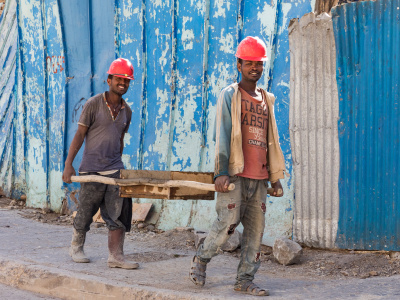
Strengthening private sector engagement in job creation in North Africa: challenges and responses
The private sector has the potential to enhance economic growth and address unemployment in North Africa. To harness the driving force of the private sector, governments need to initiate bold reforms that could create a more dynamic and innovative private sector to facilitate more inclusive and sustainable growth in the long run.
Further to the recent improvement in economic performance following episodes of instability prompted by the 2011 uprisings, the economic prospects for the North Africa region have seen a favourable shift. In 2017, the region showed an annual Gross Domestic Product (GDP) growth of 3.2% compared to 2.5% in 2016.
However, the region faces various challenges some of which are due to global dynamics, such as the fluctuating price of oil, while others are rooted in the region’s economic, demographic and social structures. Major issues include youth unemployment and poor productivity.
In 2017 the unemployment rate in North Africa reached an average of 11.7%, up from 10.9% in 2011, ranging from 9.3% in Morocco to 15.24% in Tunisia, and 17.7% in Libya. Youth unemployment is a persistent problem reaching 29.5% for the region as a whole in 2017, more than double the world average at around 13%. University graduates constitute 30% of the unemployed.
North Africa has the second largest gender gap in the world for women’s unemployment after the Middle East. According to the International Labour Organization (ILO), the unequal nature of the labour market for women is most noticeable in Arab States and North Africa due to the influence of socio-cultural factors.
Graph 1: Unemployment rate in North Africa 2010-2017

What are some of the key challenges faced by North Africa’s private sector in enhancing job creation?
Lack of structural transformation
When the makeup of GDP and employment are analysed by sector, a striking imbalance becomes apparent. For instance, the services sector dominates the GDP structure (see Graph 1). While in terms of employment, agriculture absorbs the largest share of the active population (around 50%) followed by services at 36%, and industry at almost 14%. The structure of job distribution has been largely the same since 1991 when the region experienced higher economic growth rates. These figures reflect the slow rate of structural transformation, with primary goods representing a large share of the employment figures.
Over the years, the manufacturing sector has not been able to transform itself to move up the value chain by using more advanced skills and creating higher added value. Without investing in Research & Development (R&D), the industrial sector in North Africa has not been able to reap the benefits of technological advances and innovation to generate the necessary growth to create more jobs. As a result, the workforce surplus has been absorbed into the services sector which has grown mostly in a disorganised manner in the informal sector.
North Africa has the potential to realise greater benefits from the demographic trends and a more highly educated young workforce by creating the capacity to absorb this labour into higher productivity activities. The main reasons for limited job creation include private sector dynamics, limited productivity and competitiveness, insufficient economic diversification, and openness to international markets: all of which represent areas ripe for reform.
Dynamics of the private sector
According to a World Bank report entitled ‘What’s Holding Back the Private Sector in MENA’, results from enterprise survey’ (World Bank, 2016), micro-startup firms less than five years old and with less than five employees have been the major driver of job creation in the region. In Tunisia, for example, these startups accounted for 92% of the net job creation between 1996 and 2010. Conversely, employment in older firms has stalled. Given that the private sector in North Africa has been characterised by low turnover (firm entry and exit), due to high entry costs, this has kept the pool of young firms small, limited productivity and consequently job creation.
While small enterprises are recognised to be the most innovative, generating the largest share of new jobs, they are impacted by various obstacles linked to poor governance, burdensome administrative procedures and corruption, along with the absence of a culture rooted in good performance and accountability, which are not consistent with the demands of a fast-moving and agile business world. Enterprises, particularly small ones, do not get the necessary support and access to the resources they need within the state administration to facilitate their development, and they do not have access to financing and appropriate financial tools to be able to expand locally and internationally.
Graph 2: Structure of the GDP in North Africa

Limited productivity and competitiveness
Productivity growth in North African economies suffers from the inefficient allocation of resources across firms and sectors. Examination of World Bank Enterprise Survey data reveals that countries in North Africa tend to have a wide dispersion of productivity between one another. Overall productivity is held back significantly by the limited redistribution of resources from low to high productivity firms, in the same sector and between sectors. ECA’s research on the link between the quality of institutions and structural transformation also shows that weak governance resulting from the lack of efficiency in institutions is causing resource misallocations and depriving North African countries from significant productivity gains.
North Africa is also held back by policies that create an institutional environment which fails to treat firms equally, creates barriers to entry, and impacts negatively on productivity and competitiveness.
Economic diversification and openness to world markets
North Africa’s limited economic diversification is due to its reliance on just a few sectors – such as agriculture, oil extraction and mining – and the dominance of commodity sectors, which leads to vulnerability to external shocks. Although countries like Egypt, Morocco and Tunisia have developed manufacturing capacity, elsewhere in the region such capacity is still limited.
According to a UN Economic Commission for Africa (UNECA) report on promoting Regional Value Chains in North Africa, the reduction in domestic and foreign direct investment after the 2011 uprisings had negatively affected the capacity to integrate new value chains, resulting in GDP losses of up to 2%.
In terms of international markets, oil is still the major export, representing 75% of total regional exports. Economic diversification could be enhanced by deepening regional integration. This could bring many positive outcomes, such as job creation, productivity gains and income generation that could lift millions of people out of poverty.
How to create a more dynamic, productive, competitive and job-creating private sector
Create an enabling environment
Governments should use innovative Information Technology (IT) solutions to drive more transparent administrative processes and enhance institutional performance. New technologies offer the opportunity to collect huge volumes of data more cheaply that can be analysed and used to improve government efficiency. The use of IT could help to significantly reduce policy distortions by reducing the bureaucratic burden and the discretionary power of bureaucrats. The big challenge for North Africa is to move away from a top-down approach in public policies which provide little room for firms and citizens to have a voice, to a more inclusive form of governance in which public policies pursue enhanced cooperation between governments, firms and citizens.
Mainstreaming administrative procedures will create more transparency that will help to reduce transaction costs and enable policies to be designed that are more closely aligned with the private sector’s needs. This will also drive a thorough review of the legislative framework and regulatory environment to enact laws that will promote investment, Research & Development and innovation.
Invest in human capital and Research & Development
The development of a strong and dynamic private sector is crucial to long-term economic growth. Given current technological developments, human capital will be key for the expansion of the private sector and the creation of jobs. Increasing the social return on human capital cannot be fully achieved without investing in innovation and harnessing the potential of highly specialised new economic sectors. Building R&D facilities will create more demand for skills and will help North African countries to improve their technology absorption capacity to provide the skills of the future – the key to moving up the global value chains.
The private sector has huge potential to influence the scale, quality and sustainability of skills development programmes in the R&D sector. Participation from the private sector will be vital to the success of any skills development initiative as it can have a significant impact on the scope and quality of such skill-building programmes, thereby accelerating overall economic growth.
Promote implementation of the African Continental Free Trade Area (AfCFTA) and deepen regional integration
North Africa could reap significant benefits from the implementation of the AfCFTA. The common language, geographical proximity, market size, and continuity of the maritime front from the Red Sea to the Atlantic Ocean, across the Mediterranean Sea, all represent significant strengths of the region, in terms of infrastructure it is also the most well-developed region of the Continent.
Many ECA studies show that the context is largely favourable to the development of regional value chains in sectors such as the automotive industry, the extractive industries (oil and gas), the textile industry (cotton production, fabrics, clothing and accessories), light industry (electrical, electronic and plastics) or the food industry. There are also numerous opportunities for synergy with the service sectors, e.g. with education, transport, banking, logistics and distribution, as well as the IT-based service sectors.
The study entitled ‘Industrialization through Trade in North Africa: in the context of the Continental Free Trade Area and Mega Trade Agreements’ (ECA, 2017) states that North African firms could capture up to 20% of this intra-continental trade, the equivalent of US$13.6 billion. Intra-North African trade would account for US$7.1 billion of this amount, with US$6.5 billion accounting for exports from North Africa to the rest of the continent. This gain can only be driven by the private sector, which in turn will boost opportunities and provide jobs for all.
Bold reforms badly needed
The private sector could play a major role in enhancing economic growth and creating decent jobs in North Africa. To harness the driving force of the private sector, governments must initiate bold reforms that will create an enabling business environment, support the development and sustainability of small and medium-sized enterprises (SMEs), provide a level playing field, promote value addition, and deepen regional integration both within North Africa and with the rest of the Continent.
These reforms will create a more dynamic and innovative private sector, and facilitate more inclusive and sustainable growth in the long run. Enabling further research on existing distortions and productivity losses within countries’ economies could also help improve the understanding of economic distortions North African economies are faced with and their impact, to better understand which policies are needed to fight these phenomena.
About the author
Lilia Hachem Naas is Director of the United Nations Economic Commission for Africa (UNECA) Office for North Africa in Rabat, Morocco. A Tunisian national, Ms Hachem Naas has worked for the United Nations for more than 20 years. Before joining the United Nations Economic Commission for Africa (UNECA), Ms Hachem Naas was head of the Office for Arab States at the International Trade Centre (ITC) in Geneva.
Read the full magazine issue







